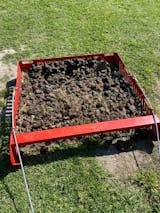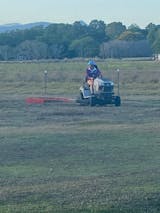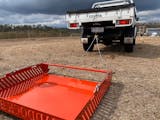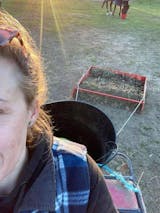
If you're like me, you know that building a strong bond with your horse is essential for a harmonious partnership. And one of the most effective ways to foster trust and cooperation is through positive reinforcement training. Building a strong relationship with your horse may come easy to some, or it may not. There are many varying factors that could play into how trust and cooperation is built between the two of you.
We're diving in to some top techniques to guide you to building trust and a healthy, bonded relationship with your equine mate. Let's talk positive reinforcement!
Positive reinforcement training is all about accentuating the positive – rewarding your horse for desirable behaviours rather than punishing or correcting unwanted ones. It's like giving your furry friend a pat on the back (or a scratch behind the ears) whenever they do something right. It's simple, effective, and oh-so-rewarding for both you and your horse.
Now, let's explore some tried-and-true techniques for incorporating positive reinforcement into your training routine:

-
Treats, treats, treats: As the old saying goes, the way to a horse's heart is through its stomach! Treats are a powerful tool in positive reinforcement training, serving as instant rewards for good behaviour. Whether it's a juicy carrot, a crisp apple, or a handful of tasty horse cookies, find out what tickles your horse's taste buds and keep a stash on hand during training sessions. Whenever your horse nails a command or behaves exceptionally well, lavish them with treats and praise. Just be sure to choose healthy, horse-friendly snacks and avoid overindulging – everything in moderation, mates!
-
Clicker training: Clicker training is a fantastic technique for fine-tuning your horse's behaviour and strengthening the bond between you. It involves using a small handheld device (usually a clicker) to mark desired behaviours, followed by a reward such as a treat or a scratch. Start by teaching your horse to associate the clicker with something positive – every time you click, follow it up with a yummy treat. Once your horse understands the connection, you can use the clicker to mark specific behaviours in real-time, making your training sessions super precise and effective. Clicker training is all about clear communication and instant feedback, helping your horse understand exactly what you're asking of them and reinforcing good habits along the way.
-
Praise and affection: Never underestimate the power of a kind word or a gentle pat! Horses are social creatures by nature, and they thrive on positive reinforcement in the form of praise and affection. So, don't be shy – shower your horse with love and encouragement whenever they do something right. Whether it's a heartfelt "good job" or a soothing rub on the neck, let your horse know just how much you appreciate their efforts. Trust me, they'll appreciate it more than you know.
-
Break it down: When it comes to training, it's essential to set realistic goals and break down complex tasks into smaller, more manageable steps. Start with the basics, like teaching your horse to respond to simple cues or commands, and gradually build up to more advanced behaviours. By taking it slow and steady, you'll set your horse up for success and keep their confidence levels sky-high. Remember, Rome wasn't built in a day – patience is key, and progress is progress, no matter how small.
-
Stay consistent: Last but not least, consistency is the cornerstone of successful positive reinforcement training. Be clear and concise with your cues, and always follow through with rewards when your horse responds correctly. Consistency breeds trust and reliability, which are the foundations of any strong relationship – equine or otherwise. Set aside regular training sessions and stick to a routine, ensuring that both you and your horse know what to expect and when to expect it. And don't forget to be patient – building trust takes time, but the payoff is well worth the effort.
-
Positive reinforcement under saddle: Positive reinforcement training isn't just for groundwork – it can also be incredibly effective when riding your horse. Use treats, praise, and other rewards to reinforce desired behaviours under saddle, such as responding to leg aids, maintaining a steady pace, or executing smooth transitions. Just be sure to reward your horse at the right moments and avoid inadvertently reinforcing unwanted behaviours. With consistent reinforcement and clear communication, you can strengthen your horse's trust in you as their rider and build a more enjoyable riding experience for both of you.

So that's a delve into positive reinforcement training, but you might be thinking what other options do you have to continue to strengthen your bond - we've got you!
Strengthening the bond and trust with horses goes beyond just positive reinforcement training. Take a read below at these additional training suggestions that can help deepen the connection between you and your equine companion:
-
Natural Horsemanship: Natural horsemanship is a holistic approach to horsemanship that emphasises communication, understanding, and partnership with the horse. It draws upon the horse's natural instincts and behaviour patterns to build trust and cooperation. Techniques such as groundwork, liberty work, and round pen exercises are commonly used in natural horsemanship training.
Groundwork involves working with the horse from the ground, using body language, voice commands, and subtle cues to communicate. This can include exercises like leading, lunging, and desensitisation work to build trust and respect. Liberty work takes this a step further, allowing the horse to move freely without physical restraint while still responding to the handler's cues and commands.
Round pen exercises are another key component of natural horsemanship, where the handler works with the horse in a round pen or enclosed space to establish boundaries, develop trust, and encourage the horse to focus and follow cues. Through natural horsemanship techniques, you can develop a deep understanding of your horse's behaviour, build a strong partnership based on trust and respect, and enhance your communication skills both on the ground and in the saddle.
-
Equine-Assisted Therapy (EAT): Equine-assisted therapy (EAT), also known as equine-assisted psychotherapy (EAP) or equine-facilitated therapy (EFT), is a therapeutic approach that involves working with horses to address emotional, psychological, or behavioural issues in humans. It can be particularly beneficial for individuals struggling with anxiety, depression, trauma, addiction, or other mental health challenges.
In equine-assisted therapy sessions, participants engage in activities with horses under the guidance of a trained therapist or facilitator. These activities may include grooming, leading, ground exercises, or simply spending time in the presence of the horse. The horse serves as a mirror for the participant's emotions and behaviours, providing valuable feedback and insights into their inner world.
Through interactions with horses, participants can learn valuable life skills such as communication, assertiveness, empathy, and boundary setting. Horses are highly sensitive and intuitive animals, capable of detecting subtle changes in human emotions and body language. As such, they can help participants develop greater self-awareness, emotional regulation, and interpersonal skills.
Equine-assisted therapy offers a unique and powerful way to strengthen the bond and trust between humans and horses while also promoting personal growth and healing. By working together with horses in a supportive and non-judgmental environment, participants can develop a deeper understanding of themselves and others, leading to positive changes in their lives.

Incorporating natural horsemanship techniques and equine-assisted therapy into your training regimen can complement positive reinforcement training and further enhance the bond and trust between you and your horse. Whether you're working on groundwork exercises, participating in therapy sessions, or simply spending quality time together, these approaches offer valuable opportunities for connection, growth, and mutual understanding.
Remember, every horse is unique, so don't be afraid to experiment and find what works best for you and your four-legged friend. These types of training are all about fostering a relationship based on trust, respect, and mutual understanding – so get out there and start bonding with your horse today!







